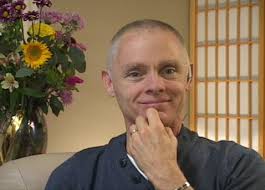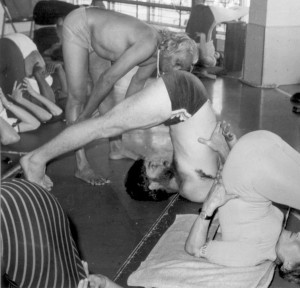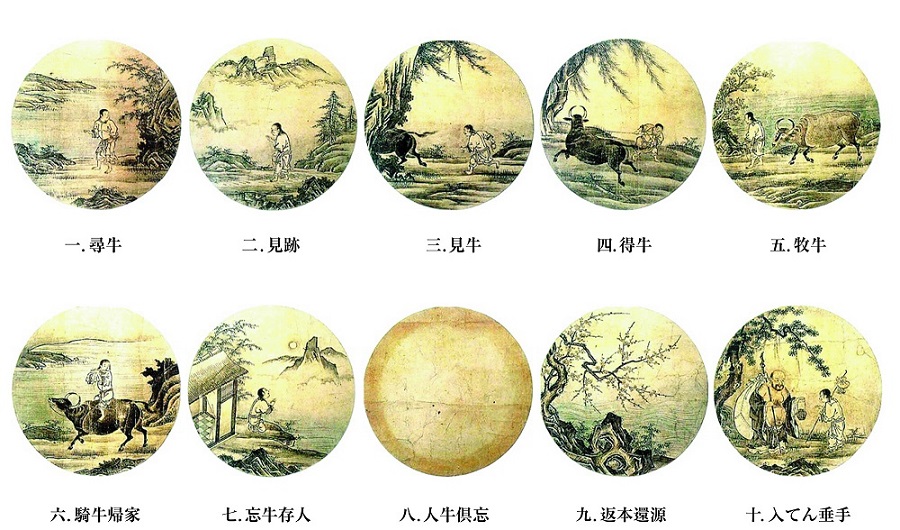Lesson 1: What is an Embodied Spiritual Practice?
This home study course is based on a somatic approach to spiritual practice based on yoga poses, breathing practices and meditation. Somatic refers to the body and this course involves embodying spiritual principles by using ou rpractices to heal and awaken cells, tissues, fluids and psyche. As we will discover in our explorations, the body is never separate from mind, spirit or wholeness, but an ongoing, evolving, tangible manifestation of divinity. The heart knows this intimately, but the mind often forgets and becomes lost in its own deluded projections.
This brings us to the word ‘spiritual’. Spirituality is the study of the heart and spiritual practice is exploring and expressing the lessons of the heart in our daily lives. The spiritual teachings coming from India, including Buddhism, Vedanta and Yoga, are beautifully clear about the wisdom of the heart. We can summarize them in three fundamental statements.
1. ‘Reality’; or the Universe, seen and unseen, creator and creation, at every level, is an unbroken interconnected whole. Everything (and no-thing) is inextricably connected to everything else.
2. The fundamental essence or nature, of any individual, you, me, or anyone, is this unbroken wholeness. In other words, the definition of “I am”, for everyone, is the wholeness of Reality.
3. This ‘Reality’ offers two perspectives to us. First is the seen; a world of impermanence, of constantly changing forms, appearing and disappearing in time. Included here are mind, body, culture, science, and more. At best we get glimpses into tiny corners of this infinite display of creation. Most of this is unseen, but waiting to be revealed. The second is not the unseen, but the Seer. Unchanging, limitless, timeless, and unmanifest wholeness, are a few of the many words that point to, not something else to be seen, but the nature of “Seeing” itself. Pure Awareness, Presence, Being are more pointer words. Awakening refers to the sudden insight that ‘Being’ is ever-present, at all times, in all places. You  cannot acquire it, nor can it be taken away. Spiritual realization is recognizing that both of these perspectives, Seer and seen, unmanifest and manifest, are valid, and the two are in fact not separate but expressions of the same “Reality. Thus the term ‘advaita’ meaning ‘not two’. Samsara is nirvana and nirvana is samsara. Spiritual integration is allowing the mind to see, study and create in the world of change, through the eyes of the heart, as divinity manifesting moment to moment.
cannot acquire it, nor can it be taken away. Spiritual realization is recognizing that both of these perspectives, Seer and seen, unmanifest and manifest, are valid, and the two are in fact not separate but expressions of the same “Reality. Thus the term ‘advaita’ meaning ‘not two’. Samsara is nirvana and nirvana is samsara. Spiritual integration is allowing the mind to see, study and create in the world of change, through the eyes of the heart, as divinity manifesting moment to moment.
Spiritual teacher Adyashanti describes these teaching and the state of the modern human in ‘The Way of  Liberation”: “The Reality that these teachings are pointing to is not hidden, or secret, or far away. You cannot earn it, deserve it, or figure it out. At this very moment, Reality and completeness are in plain sight. In fact, the only thing there is to see, hear, smell, taste, touch or feel, is Reality, or God, if you like. Absolute completeness surrounds you wherever you go. So there is really no reason to bother about it, except for the fact that we humans have long ago deceived ourselves into such a confined tangle of confusion and disarray that we can scarcely even consider, much less experience for ourselves, the divinity within and all around us.”
Liberation”: “The Reality that these teachings are pointing to is not hidden, or secret, or far away. You cannot earn it, deserve it, or figure it out. At this very moment, Reality and completeness are in plain sight. In fact, the only thing there is to see, hear, smell, taste, touch or feel, is Reality, or God, if you like. Absolute completeness surrounds you wherever you go. So there is really no reason to bother about it, except for the fact that we humans have long ago deceived ourselves into such a confined tangle of confusion and disarray that we can scarcely even consider, much less experience for ourselves, the divinity within and all around us.”
As Adyashanti describes, the ‘Truth of Reality’, especially concerning ‘ourselves’, is a bit hard to swallow for most, because we only see from one perspective, that of mind separate from the heart. We see the constant change all around us, and desperately look for stability. We see death, loss and degeneration and hold on for dear life at any graspable straw we might see. Patanjali’s Yoga Sutras offers some possible ways to help see through the ‘delusions’ we have created, and open to the possibility of ‘waking up’ to this spiritual “Reality”. This effort to see through our own confusion and awaken the voice of the heart is spiritual practice. Spiritual practice is not about ‘improving ourselves’, because, as we are already whole and unbroken, there is no-thing to improve. It means learning how to live in the world with love and compassion, as we experience the inevitable loss and change the manifest world is subject to.
 So how do we practice? According to the dictionary, to practice is: (to) perform (an activity) or exercise (a skill) repeatedly or regularly in order to improve or maintain one’s proficiency. Athletes and musicians are well known for their practice to refine their specific skills. In hatha yoga, one practices postures, movement and breathing exercises for a multitude of reasons. The health benefits, physical, physiological and psychological, are often the first to be recognized and sought after. As it takes time to change habits and retrain the body/mind to let go of less than helpful patterns and establish healthy ones, continuous practice is necessary to bring about change. This is taking place in the world of form.
So how do we practice? According to the dictionary, to practice is: (to) perform (an activity) or exercise (a skill) repeatedly or regularly in order to improve or maintain one’s proficiency. Athletes and musicians are well known for their practice to refine their specific skills. In hatha yoga, one practices postures, movement and breathing exercises for a multitude of reasons. The health benefits, physical, physiological and psychological, are often the first to be recognized and sought after. As it takes time to change habits and retrain the body/mind to let go of less than helpful patterns and establish healthy ones, continuous practice is necessary to bring about change. This is taking place in the world of form.
We all have a very tangible, physical organ called the heart, sitting on top of the diaphragm and just behind the sternum. As we dive into the moment to moment flow of fluid sensation that is our  fundamental aliveness, in every and any asana, we find the heart continuously renewing itself at the center of the flow. When, in any asana, we open our awareness to the subtle energies of the seven chakras, we find the heart at the center of the flow. We when begin the process of re-embodying our embryological origins, we find the heart right in the center. Amazing! Emaho!
fundamental aliveness, in every and any asana, we find the heart continuously renewing itself at the center of the flow. When, in any asana, we open our awareness to the subtle energies of the seven chakras, we find the heart at the center of the flow. We when begin the process of re-embodying our embryological origins, we find the heart right in the center. Amazing! Emaho!
Simultaneously, the ever-present open and compassionate heart is waiting to be noticed, independent of the forms. Fear, insecurity and anxiety, products of the mind, obscure our perception of the heart. We are seeking practices that reduce fear and anxiety and build serenity and inner calmness; practices that allow a spaciousness and lightness to be felt surrounding and interpenetrating the heart. Then, the radiant heart is seen effortlessly. As fear and anxiety, serenity and calm are embodied states, somatic practices are a great way to bring about inner peace and an awakening heart. With the help of B.K.S. Iyengar, Patanjali and many others, we will explore how our practices can be used to awaken the heart and create profound personal, and hopefully cultural, transformation. The ABC’s of spiritual awakening include:
A. Being able to differentiate and discriminate between:
1. The unbounded, unchanging all pervasive Absolute (Purusha and Drashtuh, the Seer in Patanjali’s Yoga Sutras, ‘Now’ in Eckhart Tolle, Atman/Brahman in Vedanta, ‘Being’ with Adyashanti, Buddha Nature/ Bodhi-Citta in Buddhism, etc.): and
2. The transient, constantly changing world of forms (Prakriti, creation, time and space, etc.).
B. Realizing, recognizing, remembering that the true nature of ‘you’ (the ‘I am’ we all experience) is the infinite unbounded, unlimited Purusha and not anything created in the realm of thought and posing as you.
C. Realizing that creation, the world of form, is an ongoing expression of the Divine. Prakriti is never separate from the infinite, just as the ring is never separate from the gold, even though ‘ringiness’ is different from gold. In other words, differentiated does not mean separate in this case. Samsara is nirvana; nirvana is samsara. We are all “Unique” in the world of form, and “Universal” as our True Self.
When the Hsin Hsin Ming starts to resonate with you, you will know you are on the right track! See also Bhagavad Gita, which we will study later in the course. In the next chapter we will look at the first actual practice, mindfulness, and see why it is the starting point of our journey.


